
When it comes to the complex network of veins that run throughout the human body, even the smallest problem below the surface of the skin can cause a rippling effect in health. While veins work hard to move blood between the body’s extremities and back to the heart once more every day, a collection of important one-way valves ensures that blood moves in the right direction, against the force of gravity. When one of these valves malfunctions, it doesn’t take long for issues to follow.
Blood quickly begins to flow in the opposite direction, generally towards the lower half of the body and with nowhere else to go, can begin to pool in the veins of the legs.
With enough time, pressure begins to build within the walls of the veins causing them to bulge at the surface of the skin. This condition is known as varicose veins and is often accompanied by a painful set of symptoms that might include anything from swelling and heat at the problematic area to skin that is discolored and uncomfortable to the touch.
Vein Stripping Solutions of the Past
Individuals suffering from varicose veins often endure a progression of painful symptoms, particularly when these veins go untreated. In the past, individuals looking to have varicose veins reduced or eliminated were faced with the difficult decision of continuing to live with the condition or undergo vein stripping. This highly-invasive and rather risky procedure came with a significant hospital stay, the risk of follow-up infections, as well as a lengthy and often painful recovery period. Varicose vein stripping involves the use of general anesthesia which always includes the risk of adverse reactions. During the procedure, large incisions are made across the affected areas of the body and varicose veins are surgically removed. While this process is guaranteed to eliminate the veins, it’s often associated with significant scarring at the treatment site.
This collection of potential issues surrounding vein stripping makes this procedure very much a last resort in the modern world of cosmetic services and vein health. Incredible advancements in technology have provided individuals with varicose veins options for laser vein treatment that are both highly effective and minimally invasive with wonderfully reduced recovery times, including Endovenous Laser Ablation Therapy. While vein stripping is still a viable vein treatment option at many clinics today, it’s often exclusively recommended for the most severe cases of varicose veins when modern laser techniques may not be as effective.
Alternative Vein Stripping Options
In the modern age of vein treatment solutions, the vast majority of patients will be recommended a form of laser or radiofrequency vein ablation that can be done in the comfort of an attending physician’s office over the course of a single afternoon. Patients are often thrilled to learn that these techniques save on time but also come with the successful results they’ve been hoping to see. Before a singular treatment option is decided upon, many patients will undergo vein ultrasound mapping. This non-invasive procedure gives the attending physician a chance to look more closely at the individual’s entire network of veins to be able to more precisely pinpoint those areas that are clearly disrupted and potentially pick out areas where future venous insufficiencies may occur. In this way, mapping is both an active process in deciding on immediate treatment options as well as an important preventative step when it comes to overall vein health.
Endovenous Laser Ablation Therapy
One of the most common approaches to reducing or eliminating varicose veins today as an alternative to vein stripping is Endovenous Laser Ablation Therapy (EVLT). This process is considered an outpatient procedure and involves the use of nothing more than a local anesthetic to numb the treatment site and keep patients comfortable from start to finish. A small incision is made at the treatment site and a small probe is used to access the problematic vein at the source. Once the vein is reached, the probe is used to emit precision laser energy which works to heat and close the vein. Ultimately, the varicose vein collapses and is reabsorbed naturally and safely into the body. Blood that was pooling in the vein is redirected towards healthier veins in the network without damage occurring to surrounding tissue. In much the same way, physicians may recommend the use of Radiofrequency Ablation which performs the same heath and collapse technique at a problematic vein but utilizes radiofrequency energy instead.
Sclerotherapy
An additional option to be considered as an alternative to vein stripping is sclerotherapy. This technique is also an outpatient procedure that utilizes nothing more than a local anesthetic at the treatment site. During the procedure, a small needle is used to inject either a foam or liquid sclerosant into the troubled vein in order to irritate the vessel to the point of closure and collapse. While liquid sclerosant is proven to be highly successful, some physicians prefer foam as it sticks more closely to the vein wall and provides less of a chance of interference within the surrounding blood system.
Contact Us Today
When you’re ready to partner with the vein health professionals, be sure to contact Dr. Wright and his team today at the St. Louis Laser Vein Center. From general care to diagnosis and treatment, we proudly take a comprehensive approach to each and every patient’s case.
